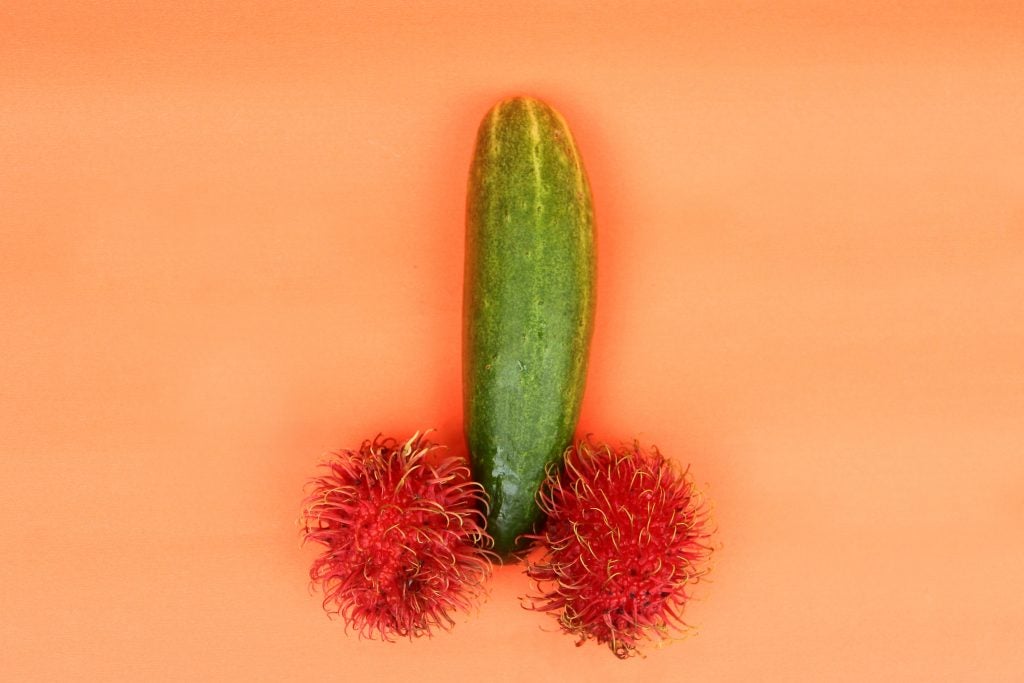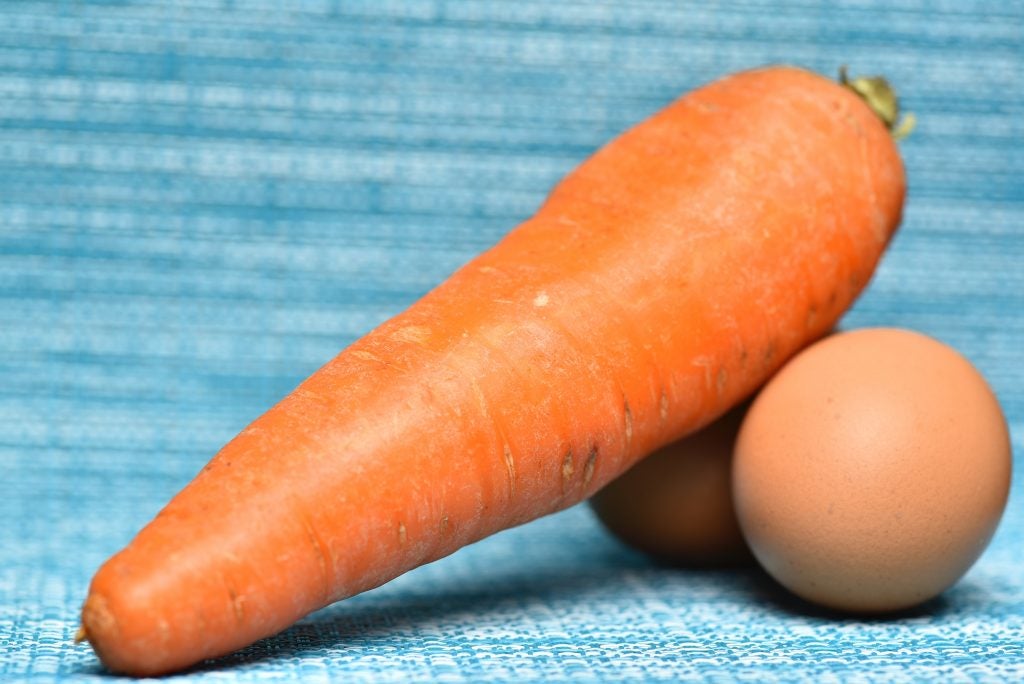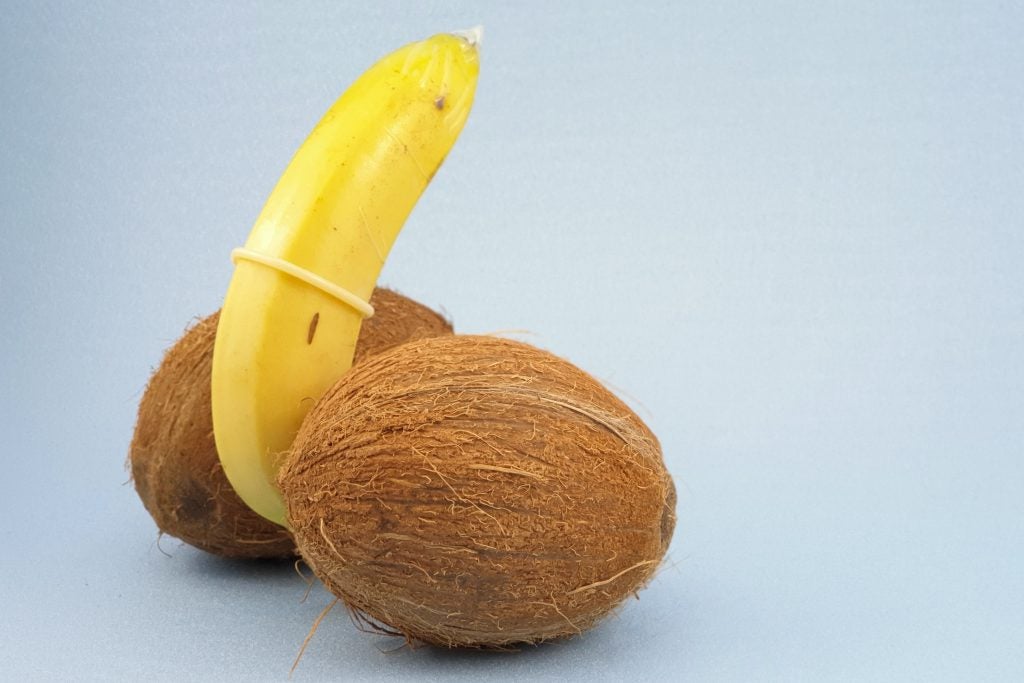
Typically, males have two testes. The testes are contained within the scrotal sac, located beneath the penis and in front of the anus. They are round in shape and tend to be about the same size as golf balls. Testicles are attached to the body via the spermatic cords, which are cord-like tissue structures formed by the vas deferens that run to each testicle. The spermatic cords carry the sperm from the testicle, to the vas deferens, and towards the prostate where they exit via the urethra.1
Testes, also called testicles, are the male reproductive organs responsible for producing sperm. Sperm are the cells that hold the male genetic makeup necessary for reproduction.1 Singularly known as testis, testes are also responsible for producing androgens, including the sex hormone testosterone. Testosterone is important for creating and maintaining male physical traits during and after puberty and for spermatogenesis.2 Testes produce up to 12 trillion sperm over the course of a male’s lifetime, with about 400 million released with each ejaculation.1
The testes grow drastically during puberty, which occurs from the ages of 11 to 17. As more testosterone is produced and released from the growing testes, more sperm are also produced. Both testes are usually of similar size, but it is normal for one to be slightly larger than the other. However, if one testicle is much bigger than the other and is painful, that might be a sign of testicular torsion.5
Testes have the ability to regulate their temperature. This is crucial because the temperature within the testicles has to be within a specific range in order for them to produce viable sperm at an optimal level. Sperm production calls for an environment that is a few degrees cooler than the human body’s normal temperature. In order to effectively regulate its temperature, the testes control how close or far away they are to the body. For example, the testes tend to drop lower in hotter temperatures in an attempt to cool down, and vice versa in colder weather. Testicles also lower during intense exercise as the internal body temperature rises, and they need to keep cool.5
Table of Contents
Anatomy of the Testes

Seminiferous Tubule
Seminiferous tubules are thin, tightly coiled tubes that are found in great numbers within the testicles. They are the site of germination, maturation, and transportation of sperm within the testicles. The cells that produce sperm called, Sertoli cells, are full of nutrients that support the function and development of sperm, in a process called spermatogenesis.2 Special tissue that fills the spaces between the seminiferous tubules, called Leydig cells, produce testosterone.2
Epididymis
The epididymis is a thin, extremely convoluted tubular structure that is attached to the top and back surface of each testicle to produce and store sperm.5 After being produced in the testicles, mature sperm are stored in the epididymis for a week while the sperm continue to mature, after which they are transported to the vas deferens.2
Spermatic Cord
The spermatic cord contains a bundle of nerves, blood vessels, lymphatic vessels, and the vas deferens. Each testis has one spermatic cord that connects it to the rest of the body. The spermatic cord also contains the cremaster muscle, which contracts to pull the testicles closer to the body in cold temperatures and during sexual arousal. The muscle also facilitates the passage of semen, which travels from the vas deferens, through the testicles, to the urethra. Issues with the function of the spermatic cord may result in an inability to develop and maintain an erection.4
Vas Deferens
The two vasa deferentia are long, slender tubes that carry sperm up from the epididymis and into the ejaculatory ducts. The tubes loop around the side of the bladder and terminate near the seminal vesicle. Each vas deferens transports mature sperm from the epididymis to the ejaculatory ducts, like the urethra, for ejaculation. The mature sperm from the vas deferens join with other secretions from the Cowper’s gland, prostate gland, and seminal vesicles, which together create semen. During a vasectomy, the two vasa deferentia are severed as a form of male sterilization.5
Blood Vessels and Nerves
The testes have a high concentration of nerves on the scrotal skin surrounding them, causing them to be very sensitive.2 The arteries, veins, and nerves found within each testicle are located in the spermatic cord and work in conjunction to regulate temperature in the testes.5
Scrotum
The scrotum, otherwise known as the scrotal sac, contains and protects the testicles. The scrotum is divided into two sections by a fold in the skin that separates the two testes. The testicles lower into the scrotum during puberty and remain there for the rest of the male’s life. The scrotum controls the movement of the testes in order to regulate their temperature to ensure optimal sperm production.6
Injury and Protection

Testicles are very sensitive to injury. Since the testicles are located in the scrotum, a sack of skin that is located outside of the body and hangs down under the penis, their location allows for testicular accidents to occur relatively often. Because the testes play such a crucial role in sperm production and male reproductive abilities, they have many nerve endings responsible for alerting the nervous system of possible danger or impact to the testes. Blunt trauma does not generally cause any permanent damage to the scrotum or testes, but may cause temporary back and abdominal pain. On the other hand, injuries that cut or pierce the scrotum or testicles can have long-lasting effects that can result in sterilization. Rupture, fracture, development of a contusion, torsion, hematoceles, or dislocation are some testicular injuries that can lead to castration or sterility.5
Protect your testicles from injury by wearing a jock strap or hard cup during contact sports, buying a bicycle seat that has a groove or cutout area to help reduce pressure on the nerves and arteries feeding the penis and testes, and wearing a seat belt (as most testicular injuries come from car accidents). 5
Health Issues
Several health issues may occur with your testicles. Some are genetic or medical issues that you cannot control; however, others can be prevented, such as injuries.
Of 8,800 cases reported, 400 males die of testicular cancer per year, most commonly between the ages of 20 to 40. Although testicular cancer is relatively rare and highly treatable, it is important that males know how to give themselves a self-examination to check for lumps that may indicate the development of a tumor. Any sign of lumps, redness, pain, or other changes or discomfort should be immediately presented to a doctor for further consultation. In the case that one has testicular cancer, treatments such as surgery, radiation, and chemotherapy may result in infertility.5
Testicular torsion occurs when the spermatic cord that provides blood flow to the testicle rotates and becomes twisted. This is usually caused by an injury or medical condition. The lack of blood flow causes severe pain and swelling. The treatment for testicular torsion is immediate surgery, as waiting too long could lead to permanent damage to the affected testis. Testicular torsion is most common in males between the ages of 10 and 25 as a result of puberty during which the testes drop and have a higher chance of twisting the spermatic cord; however, it can also occur in babies and older males.5
Epididymitis is the inflammation of the epididymis as a result of a viral or bacterial infection, such as gonorrhea or chlamydia. It is marked by severe scrotum pain and swelling that may be warm to the touch. The safest way to prevent against epididymitis is to practice safe sex that prevents the spread of sexually transmitted infections (STIs). If you think you may have epididymitis, it is best to consult a doctor and get a urine test to check for an STI. These infections are easily treated with antibiotics. In addition, painkillers may help ease the pain and inflammation. Once treated, there are usually no permanent effects.5
Hydrocele is another noncancerous testicle health issue that is a result of injury to the testicle. It is noted by a swelling of the scrotum as fluid builds up around the testicles. It usually goes untreated unless the swelling becomes uncomfortable or unbearable to manage. Treatment usually consists of draining the fluid with a syringe.5
Lastly, one can develop a varicocele, which is a varicose vein within the testicle. A variocele is recognized by swelling and fertility problems. About 10 to 15% of males develop a variocele throughout their lifetime, usually on the left testicle. Varicocele is not preventable and can be caused by a damaged valve in the vein that drains blood from the testicles. Varicoceles usually go untreated with only the aid of supportive underwear; however, if one has fertility issues, the doctor may recommend surgical options to try to restore fertility.5
An Erogenous Zone

The scrotum and testes can be a highly erogenous zone for men. The testicles are very sensitive, but when touched in the right way, the experience can be very pleasurable for males.
One technique to stimulate the scrotum is to cup the scrotum with a hand and gently move the fingers. Doing so can also be very enjoyable when combined with oral sex so the penis and the testes are stimulated simultaneously.3 Once you are comfortable with fondling this area, licking the area between testicles can be very arousing (combine this with manual masturbation for more pleasure). The testicles can be a great erogenous zone for many males, so remember to start off slow, communicate, and enjoy!3
Concluding Remarks
Since testicles are so sensitive, it is extremely important to take proper precautions when it comes to protecting them. The testes are unique organs, that play a apart in both procreation and pleasure. Consider incorporating stimulation of the testicles into one’s love life as it can contribute an added layer of satisfaction for both partners.
Check out this great video about testicles!
References
- Taylor, Tim. Testes. InnerBody. Web.
- Utiger, M.D. Robert D. “Testis (anatomy).” Encyclopedia Britannica Online. Encyclopedia Britannica. Web.
- “His Erogenous Zones.” His Erogenous Zones. Web.
- Healthline Medical Team. Spermatic Cord. 02 Apr. 2015. Web.
- LeVay, Simon, Janice I. Baldwin, and John D. Baldwin. Discovering Human Sexuality. Sunderland, MA: Sinauer Associates, 2009. Print.
- Heathline Medical Team. Scrotum. 01 Apr. 2015. Web.
Last Updated: 10 November 2017.
